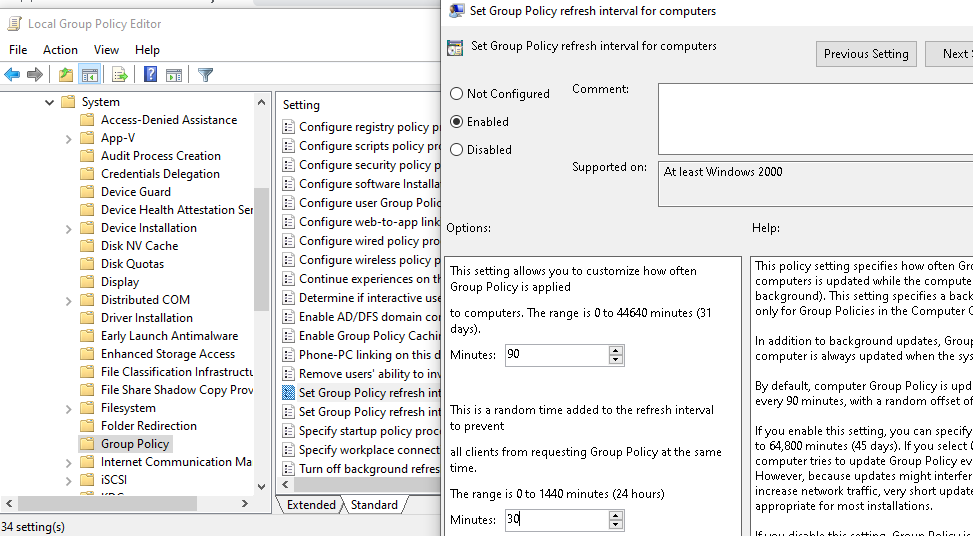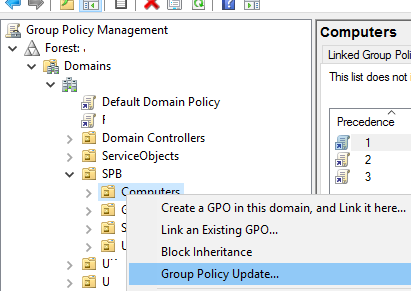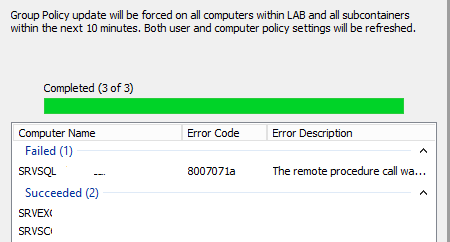- GPUPDATE – выполнение обновления групповых политик для пользователя и компьютера.
- Способы обновления групповых политик Windows на компьютерах домена
- Интервал обновления параметров групповых политик
- GPUpdate.exe – команда обновления параметров групповых политики
- Принудительно обновление политики из консоли Group Policy Management Console (GPMC)
- Invoke-GPUpdate – обновление GPO из Powershell
- How To Run gpupdate /force On Windows?
- Get Help
- Force Only
- Update Only User Policies
- Update Only Computer Policies
- Force and Reboot
- Force and Logoff Account
- Set Timeout To Force gpupdate
- Force gpupdate with PowerShell
- Force a Remote Group Policy Refresh (GPUpdate)
- Prerequisites
- Step 1: Configure firewall rules on each client that will be managed with remote Group Policy refresh
- To create a GPO from the Group Policy Remote Update Firewall Ports Starter GPO and link to the domain
- Step 2: Schedule a remote Group Policy refresh
- To schedule a Group Policy refresh to run on all computers in an OU by using the GPMC
GPUPDATE – выполнение обновления групповых политик для пользователя и компьютера.
Команда GPUPDATE используется для обновления групповых политик для пользователя и/или компьютера .
Формат командной строки:
GPUpdate [/Target:
Параметры командной строки:
/Target:
/Force — Применение всех параметров политики. Если не указано, применяются только изменившиеся параметры политики.
/Wait:значение — Время ожидания (в секундах) завершения обработки политики. По умолчанию — ожидание 600 секунд. Значение ‘0’ — без ожидания. Значение ‘-1’ — ожидание не ограничено. В случае превышения времени ожидания вновь активизируется окно командной строки, но обработка политики продолжается.
/Logoff — Выполнение выхода после обновления параметров групповой политики. Требуется для тех клиентских расширений групповой политики, которые не обрабатывают политику в фоновом режиме, а обрабатывают ее только при входе пользователя, таких, например, как установка программ для пользователя или перенаправление папок. Этот параметр не оказывает влияния, если не вызываются расширения, требующие выхода пользователя.
/Boot — Выполнение перезагрузки после применения параметров групповой политики. Требуется для тех клиентских расширений групповой политики, которые не обрабатывают политику в фоновом режиме, а обрабатывают ее только при запуске, таких, например, как установка программ для компьютера. Этот параметр не оказывает влияния, если не вызываются расширения, требующие перезапуска системы.
/Sync — Следующее активное применение политики должно выполняться синхронно. Активные применения политики происходят при перезагрузке компьютера или при входе пользователя в систему. Можно использовать этот параметр для пользователя, компьютера или для обоих, задав параметр /Target. При этом параметры /Force и /Wait, если они указаны, пропускаются.
gpupdate /? — отобразить подсказку по использования команды.
gpupdate — выполняется обновление политик компьютера и политик пользователя. Применяются только изменившиеся политики.
gpupdate /Target:computer — выполняется обновление политик только для компьютера.
gpupdate /Force — выполняется обновление всех политик.
gpupdate /Boot — обновление групповых политик с перезагрузкой компьютера.
Способы обновления групповых политик Windows на компьютерах домена
В этой статье мы рассмотрим особенности обновления параметров групповых политик на компьютерах домена Active Directory: автоматическое обновление политик, команду GPUpdate , удаленное обновление через консоль Group Policy Management Console ( GPMC.msc ) и командлет PowerShell Invoke-GPUpdate .
Интервал обновления параметров групповых политик
Чтобы новые настройки, которые вы задали в локальной или доменной групповой политике (GPO) применились на клиентах, необходимо, чтобы служба Group Policy Client перечитала политики и внесла изменения в настройки клиента. Это процесс называется обновление групповых политик. Настройки групповых политик обновляются при загрузке компьютере и входе пользователя, или автоматически в фоновом режиме раз в 90 минут + случайное смещение времени (offset) в интервале от 0 до 30 минут (т.е. политики гарантировано применятся на клиентах в интервале 90 – 120 минут после обновления файлов GPO на контроллере домена).
Вы можете изменить интервал обновления настрое GPO с помощью параметра Set Group Policy refresh interval for computers, который находится в секции GPO Computer Configuration -> Administrative Templates -> System -> Group Policy.
Включите политику (Enabled) и задайте время (в минутах) в следующих настройках:
- This setting allow you to customize how often Group Policy is applied to computer (от 0 до 44640 минут) – как часто клиент должен обновлять настройка GPO (если указать тут 0 – политики начнут обновляться каждые 7 секунд – не стоит этого делать);
- This is a random time added to the refresh interval to prevent all clients from requesting Group Policy at the same time (от 0 до 1440 минут) – максимальное значение случайного интервал времени, которые добавляется в виде смещения к предыдущему параметру (используется для уменьшения количества одновременных обращений к DC за файлами GPO от клиентов).
GPUpdate.exe – команда обновления параметров групповых политики
Всем администраторов знакома команда gpupdate.exe, которая позволяет обновить параметры групповых политик на компьютере. Большинство не задумываясь используют для обновления GPO команду gpupdate /force . Эта команда заставляет компьютер принудительно перечитать все политики с контроллера домена и заново применить все параметры. Т.е. при использовании ключа force клиент обращается к контроллеру домена и заново получает файлы ВСЕХ нацеленных на него политик. Это вызывает повышенную нагрузку на сеть и контроллер домена.
Простая команда gpudate применяет только новые/измененные параметры GPO.
Если все OK, должны появится следующие строки:
Можно отдельно обновить параметры GPO из пользовательской секции:
или только политики компьютера:
gpupdate /target:computer /force
Если некоторые политики нельзя обновить в фоновом режиме, gpudate может выполнить logoff текущего пользователя:
gpupdate /target:user /logoff
Или выполнить перезагрузку компьютера (если изменения в GPO могут применится только во время загрузки Windows):
Принудительно обновление политики из консоли Group Policy Management Console (GPMC)
В консоли GPMC.msc (Group Policy Management Console), начиная с Windows Server 2012, появилась возможность удаленного обновления настроек групповых политик на компьютерах домена.
Add-WindowsCapability -Online -Name Rsat.GroupPolicy.Management.Tools
Теперь после изменения настроек или создания и прилинковки новой GPO, вам достаточно щелкнуть правой клавишей по нужному Organizational Unit (OU) в консоли GPMC и выбрать в контекстном меню пункт Group Policy Update. В новом окне появится количество компьютеров, на которых будет выполнено обновление GPO. Подтвердите принудительное обновление политик, нажав Yes.
Затем GPO по очереди обновяться на каждом компьютере в OU и вы получите результат со статусом обновления политик на компьютерах (Succeeded/Failed).
Данная команда удаленно создает на компьютерах задание планировщика с командой GPUpdate.exe /force для каждого залогиненого пользователя. Задание запускается через случайный промежуток времени (до 10 минут) для уменьшения нагрузки на сеть.
- Открыт порт TCP 135 в Windows Firewall;
- Включены службы Windows Management Instrumentation и Task Scheduler.
Если компьютер выключен, или доступ к нему блокируется файерволом напротив имени такого компьютера появится надпись “The remote procedure call was cancelled”.
По сути этот функционал дает тот же эффект, если бы вы вручную обновили настройки политик на каждом компьютере командой GPUpdate /force .
Invoke-GPUpdate – обновление GPO из Powershell
Также вы можете вызвать удаленное обновление групповых политик на компьютерах с помощью PowerShell комнадлета Invoke-GPUpdate (входит в RSAT). Например, чтобы удаленно обновить пользовательские политики на определенном компьютере, можно использовать команду:
Invoke-GPUpdate -Computer «corp\Computer0200» -Target «User»
При запуске командлета Invoke-GPUpdate без параметров, он обновляет настройки GPO на текущем компьютере (аналог gpudate.exe).
В сочетании с командлетом Get-ADComputer вы можете обновить групповые политики на всех компьютерах в определенном OU:
Get-ADComputer –filter * -Searchbase «ou=Computes,OU=SPB,dc=winitpro,dc=com» | foreach
или на всех компьютерах, которые попадают под определенный критерий (например, на всех Windows Server в домене):
При удаленном выполнении командлета Invoke-GPUpdate или обновления GPO через консоль GPMC на мониторе пользователя может на короткое время появиться окно консоли с запущенной командой gpupdate .
How To Run gpupdate /force On Windows?
gpupdate command is used to update Group policies in Windows operating system Domain. There are different options to use with the gpupdate but one of the most used option is /force which will reapply all policy settings.
Get Help
Even “gpupdate” command provides very basic features we may need to get some help about the options. We can list help information by using /? option like below. This will list options and option explanation of the “gpupdate” command.
Force Only
We can force to reapply all group policy settings with the /force option. The default behavior of the /force option is only update changed policies.
As we can see from screenshot User and Computer policies are updated successfully.
Update Only User Policies
By default all policies will be updated with the “gpupdate” command. If we want to update only the policies related with the user objects wen need to specify the /Target:User options to the “gpupdate” command like below.
Update Only Computer Policies
Alternatively, we can only update computer object-related policies with the option /Target:Computer like below.
Force and Reboot
If we want to force and make the system restart or reboot we should provide the option /boot next to the option /force like below.
Force and Logoff Account
We can also log off from the current session or account after updating the group policy forcibly. We will provide the /logoff option after the option /force like below.
Set Timeout To Force gpupdate
Updating group policy may take some time or run forever if there is a problem. This problem can be a network or domain-related problem. Especially in remote branches network problems are very popular. We can set a time that will stop the update if it is not completed. We call this a timeout and use /w option and provide a time.
In this example, we will wait for 120 seconds in order to complete a group policy update.
Force gpupdate with PowerShell
gpupdate command can be used in PowerShell too. We can use -force option like below with Invoke-GPUpdate command.
Force a Remote Group Policy Refresh (GPUpdate)
Applies To: Windows Server 2012 R2, Windows Server 2012
Group Policy is a complicated infrastructure that enables you to apply policy settings to remotely configure a computer and user experience within a domain. When the Resultant Set of Policy settings does not conform to your expectations, a best practice is to first verify that the computer or user has received the latest policy settings. In previous versions of Windows, this was accomplished by having the user run GPUpdate.exe on their computer.
With Windows Server 2012 and Windows 8, you can remotely refresh Group Policy settings for all computers in an organizational unit (OU) from one central location by using the Group Policy Management Console (GPMC). Or you can use the Invoke-GPUpdate Windows PowerShell cmdlet to refresh Group Policy for a set of computers, including computers that are not within the OU structure—for example, if the computers are located in the default computers container.
The remote Group Policy refresh updates all Group Policy settings, including security settings that are set on a group of remote computers, by using the functionality that is added to the context menu for an OU in the Group Policy Management Console (GPMC). When you select an OU to remotely refresh the Group Policy settings on all the computers in that OU, the following operations happen:
An Active Directory query returns a list of all computers that belong to that OU.
For each computer that belongs to the selected OU, a WMI call retrieves the list of signed in users.
A remote scheduled task is created to run GPUpdate.exe /force for each signed in user and once for the computer Group Policy refresh. The task is scheduled to run with a random delay of up to 10 minutes to decrease the load on the network traffic. This random delay cannot be configured when you use the GPMC, but you can configure the random delay for the scheduled task or set the scheduled task to run immediately when you use the Invoke-GPUpdate cmdlet.
This document describes a method to force a remote Group Policy refresh to all computers in an OU and all OUs that are contained within the selected OU by using the GPMC. An equivalent Windows PowerShell method is also presented for each procedure.
In this document
This topic includes sample Windows PowerShell cmdlets that you can use to automate some of the procedures described. For more information, see Using Cmdlets.
Prerequisites
You can only schedule to force a remote Group Policy update by using the GPMC from domain-joined computers that are running:
Windows Server 2012 or Windows Server 2012 R2
Windows 8 or Windows 8.1 with Remote Server Administration Tools for Windows 8
You can schedule a remote Group Policy refresh for any computer running:
Windows Server 2012 R2
Windows Server 2012
WindowsВ ServerВ 2008В R2
WindowsВ ServerВ 2008
Step 1: Configure firewall rules on each client that will be managed with remote Group Policy refresh
To schedule a Group Policy refresh for domain-joined computers by using the GPMC or the Invoke-GPUpdate cmdlet, you must have firewall rules that enable inbound network traffic on the ports listed in the following table.
Type of network traffic
TCP RPC dynamic ports, Schedule
(Task Scheduler service)
Remote Scheduled Tasks Management (RPC)
TCP port 135, RPCSS
(Remote Procedure Call service)
Remote Scheduled Tasks Management (RPC-EPMAP)
TCP all ports, Winmgmt
(Windows Management Instrumentation service)
Windows Management Instrumentation (WMI-in)
In Windows Server 2012, Group Policy added a Starter GPO called, Group Policy Remote Update Firewall Ports. This Starter GPO includes policy settings to configure the firewall rules that are specified in the previous table. It is a best practice to create a new GPO from this Starter GPO. Link the GPO to your domain at a higher precedence than the Default Domain GPO, and then use it to configure all the computers in the domain to enable a remote Group Policy refresh.
To create a GPO from the Group Policy Remote Update Firewall Ports Starter GPO and link to the domain
In the GPMC console tree, locate the domain for which you want to configure all the computers to enable a remote Group Policy refresh.
Right-click the selected domain, and click Create a GPO in this domain, and link it here…
In the New GPO dialog box, type the name of the new Group Policy object in the Name box.
In the Source Starter GPO list, select the Group Policy Remote Update Firewall Ports Starter GPO that you want to use to create a new Group Policy object, and click OK.
In the results pane, click the Linked Group Policy Objects tab.
Select the GPO that you just created, and click the Up arrow until the GPO is listed above the Default Domain Policy. The new GPO will have a smaller link order value than the Default Domain Policy.
.jpeg)
The following Windows PowerShell cmdlet or cmdlets perform the same function as the preceding procedure. Enter each cmdlet on a single line, even though they may appear word-wrapped across several lines here because of formatting constraints.
Use the New-GPO cmdlet with the –StarterGpoName parameter, and then pipe the output to the New-GPLink cmdlet.
For example, to create a new GPO called Configure firewall rules for remote gpupdate by using the Group Policy Remote Update Firewall Ports Starter GPO, then link the new GPO to the Contoso.com domain, use the following script:
For more information about the New-GPO cmdlet and the New-GPLink cmdlet, see:
Step 2: Schedule a remote Group Policy refresh
You can schedule gpupdate.exe to run on multiple computers from the GPMC or from a Windows PowerShell session using the Invoke-GPUpdate cmdlet.
To schedule a Group Policy refresh to run on all computers in an OU by using the GPMC
In the GPMC console tree, locate the OU for which you want to refresh Group Policy for all computers.
Group Policy will also be refreshed for all computers that are located in the OUs contained in the selected OU.
Right-click the selected OU, and click Group Policy Update…
Click Yes in the Force Group Policy update dialog box. This is the equivalent to running GPUpdate.exe /force from the command line.
The Remote Group Policy update results window displays only the status of scheduling a Group Policy refresh for each computer located in the selected OU and any OUs contained within the selected OU. This display does not show the success or failure of the actual Group Policy refresh for each computer.
Use Resultant Set of Policy to determine the success of the scheduled Group Policy refresh, Determine Resultant Set of Policy.
You should plan a delay of up to 10 minutes to start a Group Policy refresh when you are verifying the results for each computer.
.jpeg)
The following Windows PowerShell cmdlet or cmdlets perform the same function as the preceding procedure. Enter each cmdlet on a single line, even though they may appear word-wrapped across several lines here because of formatting constraints.
The Invoke-GPUpdate cmdlet allows you to schedule a remote Group Policy update for a specified computer with all the options that the GPUpdate.exe command-line utility provides. This allows more freedom to determine which set of computers is to be refreshed than if you schedule the refresh through the GPMC. Additionally, you have the freedom to configure the interval of time to wait before a Group Policy refresh is performed by using the –RandomDelayInMinutes parameter. If set to a zero (0) value, the scheduled task for the Group Policy refresh is configured to start immediately. For more information, see Invoke-GPUpdate.
You can refresh the changed Group Policy settings for the computer that you are signed in to by running the Invoke-GPUpdate cmdlet without including any parameters, for example:
You cannot schedule a Group Policy refresh for the Computers container by using the GPMC Group Policy Update… functionality. The Computers container is a default location for computer accounts. It is not implemented as an OU that can be managed by the GPMC. However, by combining the use of the Windows PowerShell cmdlet, Get-ADComputer, with the Invoke-GPUpdate cmdlet, you can schedule a remote refresh for all computers in the Computers container. For more information about available Windows PowerShell cmdlets for Active Directory, see AD DS Administration Cmdlets in Windows PowerShell.









